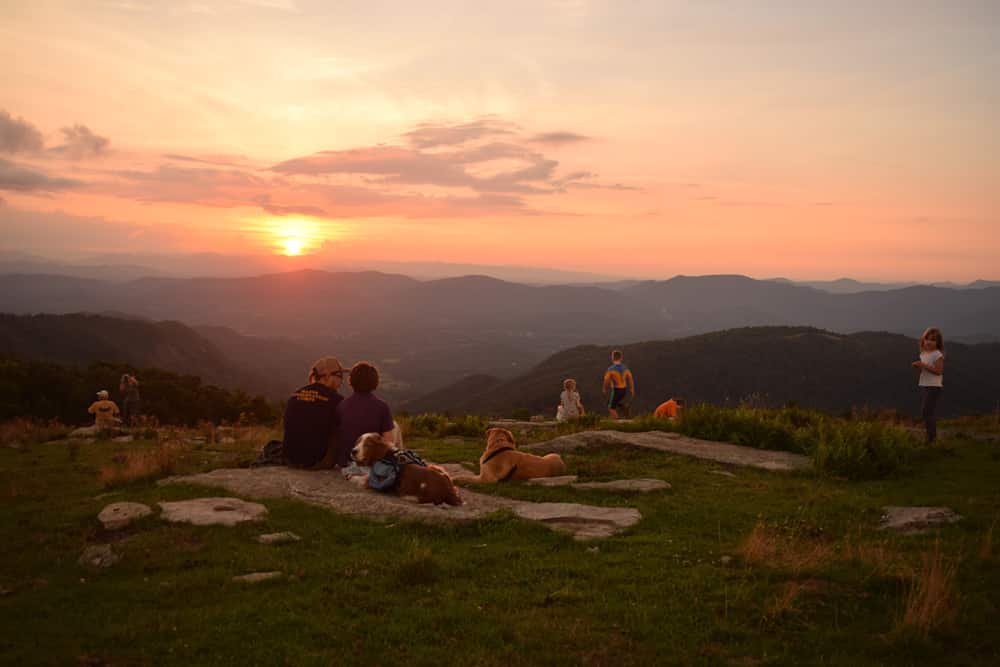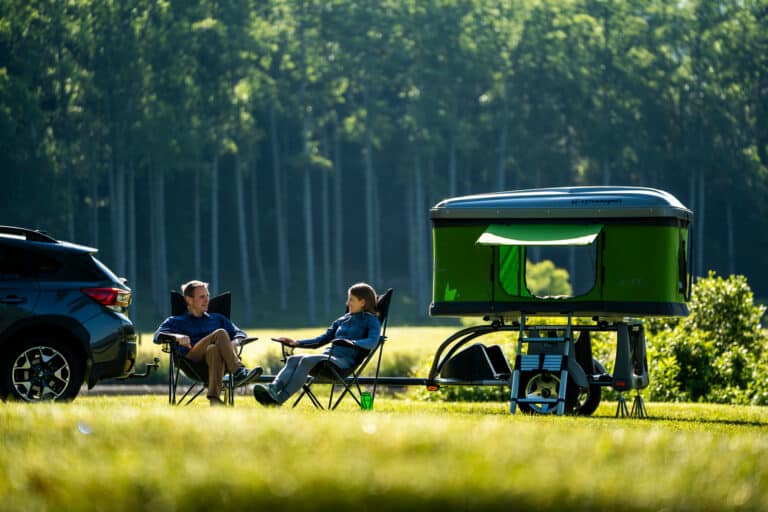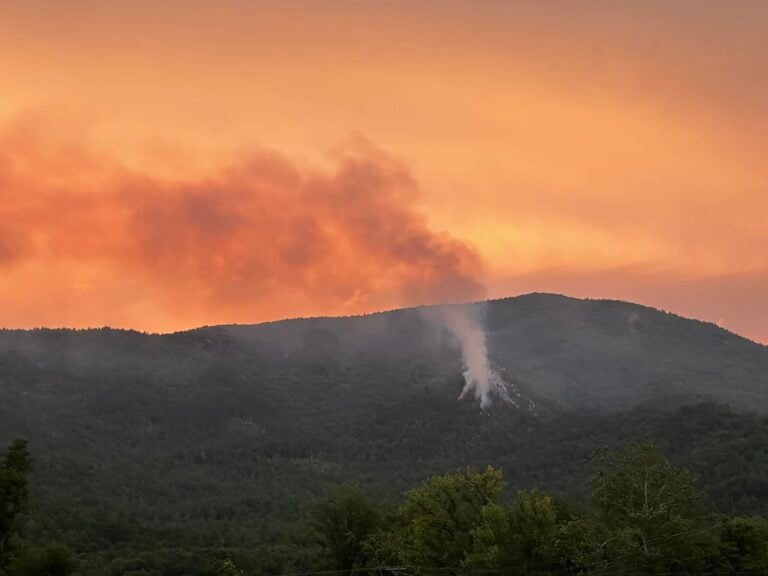From the very moment the award-winning Wildcat Rock Trail starts climbing, hikers know it’s going to be rough. In the first mile, goat-legged adventurers switchback through steep old-growth forest, passing mossy seeps and clearings with dramatic views of North Carolina’s Hickory Nut Gorge. Then, when there seems to be a whisper of relief, the trail turns sharply to reveal 136 granite stairs that fringe the face of Little Bearwallow Falls.
This is the point where ruddy-faced hikers either accept their fate or turn around. It was also a turning point for Peter Barr, trails specialist at the Hendersonville-based land trust, Conserving Carolina.
“We spent over $30,000 on what equated to about 300 linear feet of trail. That made me very nervous,” says Barr. “I remember standing at the base of those stairs with the contractor and telling him, ‘We’re taking a big risk here.’”
But Barr has built his career on big risks. For the past decade, when he wasn’t bagging all 900 miles of trails in Great Smoky Mountains National Park or authoring a book on North Carolina’s lookout towers, Barr was developing the Hickory Nut Gorge State Trail network—a 100-mile system of trails through some of North Carolina’s wildest terrain.
The trail network, which is roughly halfway complete, spans the entire Hickory Nut Gorge, a 20,000-acre canyon that cuts through Rutherford, Buncombe, and Henderson counties. The gorge is considered an ecological treasure not only because it harbors 37 rare plant species and 14 rare animal species, but also because it dishes up topographical drama. At certain points, the 14-mile-long ravine drops 1,800 feet in elevation, revealing slick granite faces and glistening cascades.
For these reasons, Conserving Carolina made it a priority to save Bearwallow Mountain, a 4,232-foot peak in the small community of Gerton, from encroaching development in 2009. The Bearwallow Mountain trailhead opened two years later.
“It became a huge success,” Barr says of the two-mile hike. “As an organization, we discovered that when people have a personal relationship with the places we protect, they have a stronger desire to get involved.”
In the years since, Conserving Carolina has partnered with other private and public landowners to safeguard thousands of acres in the Hickory Nut Gorge. The nonprofit has also carved more than 30 miles of trails through deep valleys, imposing boulder fields, and high-elevation meadows with the hopes of one day linking the segments to create a thru-hike that rivals the Mountains-to-Sea Trail.
Though the rugged terrain makes it nearly impossible to set a projected completion date for the Hickory Nut Gorge State Trail, which was officially designated by the North Carolina General Assembly in 2017, volunteers like Bob Carlson and Kim Chao are working hard to create an unrivaled hiking experience.
Carlson and Chao are faithful members of the Rock Crushers, a crew of a dozen or so trail builders who spend Wednesdays raking forest flotsam and removing rhododendron root balls. “It’s a lot like you’re wrestling a rhododendron,” Carlson says of the latter. Both he and Chao are retired teachers from Chicago with wireframe glasses and subtle Midwestern accents, but they are not to be underestimated.
Amid pandemic lockdowns last year, the couple was instrumental in building the Youngs Mountain Trail, a two-mile path near Lake Lure that ascends 1,200 feet to deliver truly awesome views of the lower Hickory Nut Gorge. With guidance from Barr, the two spent hours staging locust logs for a set of stairs. Since the logs were too heavy to lift, Chao used her legs to push while Carlson tugged with his arms.
“We’re the grunt labor,” says Chao. To which Carlson adds: “But we know what we’re doing.”
They, like Barr, also love what they’re doing. Though the region’s unforgiving topography makes trail building arduous, magic happens in the gorge.
“The Hickory Nut Gorge is one of the most spectacular landscapes in all of southern Appalachia,” says Barr. “While its terrain is very complex, creating access is worth it over and over again.”
Two Gorge-ous Day Hikes
#1 Wildcat Rock Trail to Bearwallow Mountain
Difficulty: Strenuous
Length: 10 miles round-trip
Located off Highway 74A in Gerton, Wild Cat Rock Trail begins as a gentle amble through a picturesque apple orchard and quickly evolves into something else entirely. After a creek crossing, the path ascends aggressively to Little Bearwallow Falls, a 100-foot granite face that is most impressive in the spring. The second mile continues to gain elevation, rewarding dogged adventurers with the hike’s namesake—Wildcat Rock.
The granite precipice, which was discovered back when mountain lions were more abundant, offers views of pastoral countryside and a place to scarf some granola before continuing another mile to the ridgeline of Little Bearwallow Mountain. Though the trail has historically ended at Little Bearwallow, Conserving Carolina opened a two-mile connector trail to Bearwallow Mountain in November 2020, creating a solid 10-mile day hike.
#2 Weed Patch Mountain Trail
Difficulty: Strenuous
Length: 20 miles round-trip
Weed Patch Mountain is the place to go when leaf peepers flood western North Carolina. This 20-mile jaunt is a true wilderness experience during which folks can bask in solitude and soak up long-range views. The hike starts on the Buffalo Creek Loop Trail and traverses rugged terrain that tightropes the Blue Ridge Escarpment, or the line where the Blue Ridge Mountains plunge to the foothills.
The hike’s nearly 4,000-foot ascent is sure to leave you breathless, as are the geographical features. A short spur called Tunnel Trail, for instance, takes hikers through a giant archway created by a granite slab leaning against Eagle Rock, a popular climbing destination. “It’s maybe one of my favorite trail features in the gorge,” says Barr. “It would’ve been an injustice to not bring users here.”
Cover photo: The view from Bearwallow Mountain. Photo courtesy of Conserving Carolina








